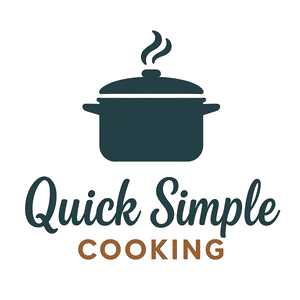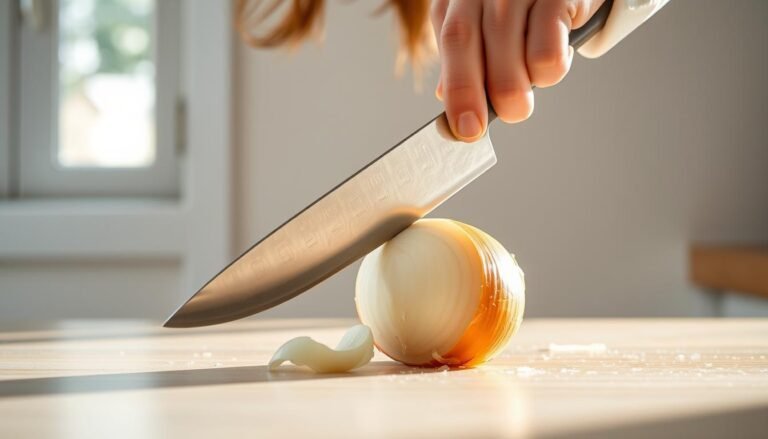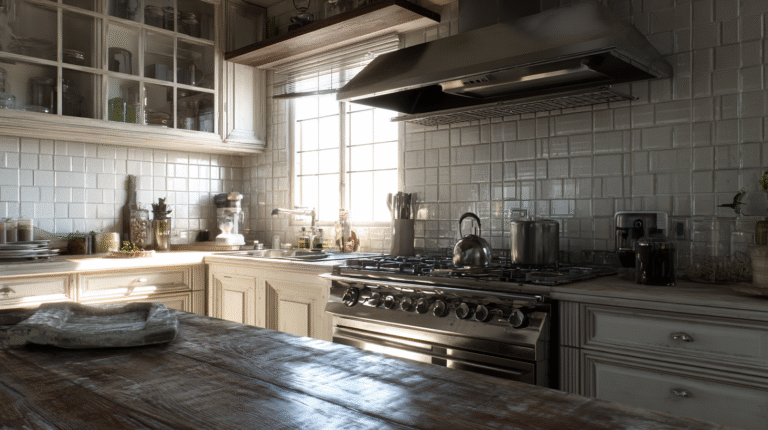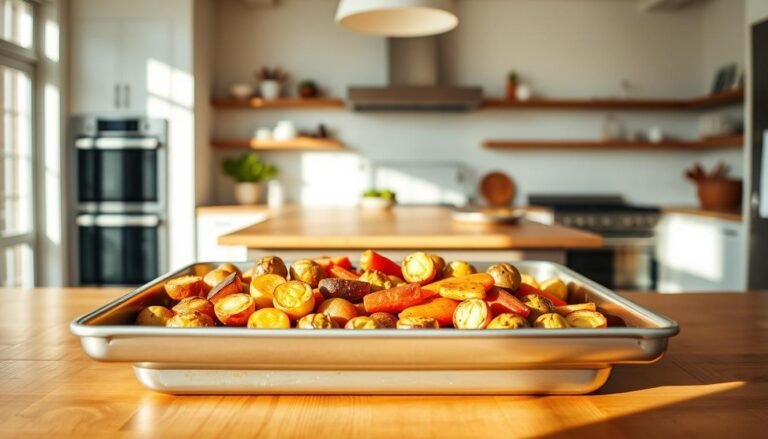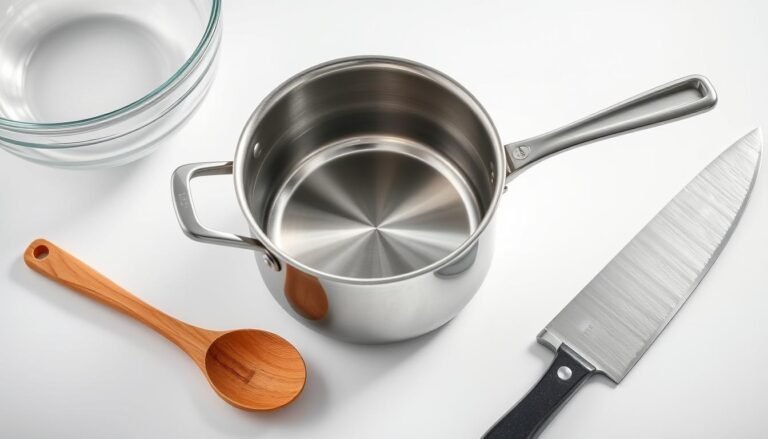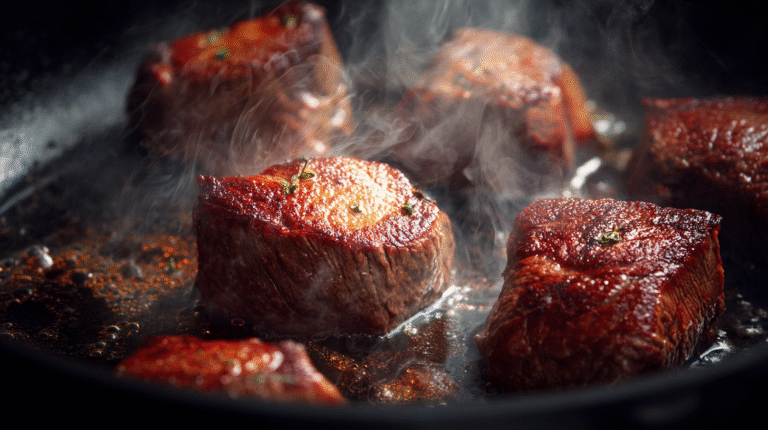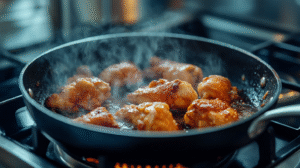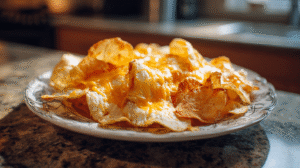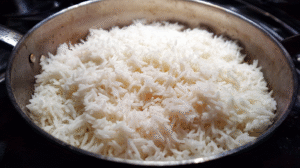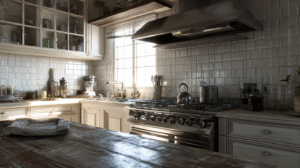Disclosure: This Post Contains Affiliate Links; We earn a commission on purchases.
Burning garlic can ruin a dish’s flavor. Instead of just chopping, try grating or smashing it. This can help you sauté it perfectly.
Knowing how to prepare and cook garlic is important. It helps avoid burnt tastes. By using the right methods, you can make your dishes better and avoid burnt garlic.
Key Takeaways
- Proper garlic preparation is key to preventing burnt flavors.
- Alternative methods like grating or smashing garlic can help.
- Understanding cooking techniques can elevate your dishes.
- Preventing burnt garlic is key for a perfect sauté.
- Garlic cooking tips can make a big difference in cooking.
Understanding Why Garlic Burns Easily
Garlic burns easily because of what it’s made of. It’s important to know why this happens when cooking with it.
The Science Behind Garlic’s Low Burning Point
Garlic has natural sugars that come out when it’s crushed or chopped. These sugars can turn into caramel quickly. But, they can also burn fast if the heat is too high. This is because garlic burns at a lower temperature than other foods.
How Garlic’s Sugar Content Affects Cooking
The sugar in garlic affects how it cooks. When garlic heats up, its sugars can go from caramel to burnt fast. This changes the dish’s flavor.
Why Burnt Garlic Ruins Dishes
Burnt garlic makes dishes taste bitter and bad. It overpowers the other flavors. This is because burning garlic creates new, bad-tasting compounds.
Proper Garlic Preparation Techniques
To cook with garlic well, knowing how to prepare it is key. The right way can really change how your food tastes and smells.
Selecting Fresh vs. Aged Garlic
Choosing between fresh and aged garlic depends on what flavor you want. Fresh garlic is sharp and great for dishes needing a strong garlic taste. Aged garlic is milder and nuttier, perfect for sauces and marinades.
Mincing vs. Slicing vs. Crushing Effects
How you prepare garlic changes its taste. Mincing garlic makes it taste stronger fast. Slicing garlic is milder because it releases fewer enzymes. Crushing garlic makes it smooth and blends well in dishes.
Preparing Garlic in Advance: Pros and Cons
Preparing garlic ahead can save time, but it might lose some flavor. Knowing the good and bad points is important.
Storage Methods That Preserve Flavor
To keep garlic flavor when preparing ahead, store it in a sealed container. Cover it with oil and keep it in the fridge. This keeps the taste and smell fresh.
When to Prepare Just Before Cooking
For dishes where garlic is the main ingredient, prepare it right before cooking. This way, the garlic’s oils are released during cooking. It makes the dish taste better.
How Can I Avoid Burning Garlic When Cooking?
Cooking with garlic can be tricky. But, with the right techniques, you can prevent burnt garlic and make your dishes better. Garlic is key in many dishes, and how you prepare it is very important.
The “Low and Slow” Approach
One good way to cook garlic without burning it is the “low and slow” method. Cook garlic over low heat for a long time. This lets its flavors come out slowly, giving a deep, rich taste without burning.
Some chefs say to mix garlic with cold oil and then heat it up slowly. This method spreads heat evenly and stops garlic from burning.
Strategic Timing: When to Add Garlic
When to add garlic is very important. Adding it after other aromatics have cooked can make it less harsh. This is a key garlic sautéing tip for chefs.
Oil Temperature Management
Keeping the oil temperature right is key when cooking with garlic. If the oil is too hot, garlic burns fast. So, it’s important to watch the oil temperature closely.
Visual Cues for Perfect Oil Temperature
Visual signs can tell you if the oil is the right temperature. If the oil starts to shimmer or slightly ripple, it’s ready for garlic. But, don’t let it smoke.
Testing Methods Before Adding Garlic
Before adding garlic, test the oil temperature with a small piece of garlic or another aromatic. If it sizzles gently, the oil is perfect. If it burns or smokes, the oil is too hot.
Essential Cookware and Tools
Cooking garlic right needs more than a recipe. You need the right cookware and tools. The right cookware helps prevent burning and brings out the flavor.
Best Pan Materials for Garlic Cooking
The pan material is very important for garlic cooking. Stainless steel and cast iron pans are top choices. They keep heat well and cook evenly, avoiding burnt garlic.
Using Heat Diffusers Effectively
A heat diffuser is great for garlic cooking, mainly over high heat. It spreads heat evenly, stopping hotspots that burn garlic. This is super helpful with gas stoves or high heat.
Digital Thermometers and Heat Control
Digital thermometers help control heat precisely. They keep the temperature right for garlic, preventing it from burning. This is key for perfect garlic cooking.
Garlic Cooking Methods by Cuisine
Garlic is key in many cuisines, each with its own way of cooking it. How garlic is cooked changes its taste and smell. This makes it a vital part of many dishes. For more on cooking, check out Kristo’s Cooks.
Italian Techniques for Garlic Infusion
In Italian cooking, garlic is mixed into oil slowly. This is done by heating garlic in cold oil. It helps keep garlic’s taste delicate.
Asian Stir-Fry Garlic Methods
Asian stir-fries add garlic at the end to stop it from burning. This quick method keeps garlic’s strong taste. Stir-frying garlic with other foods makes the dish taste better.
Mediterranean Garlic Roasting
Mediterranean cooking roasts garlic to make it sweeter. Roasting garlic cloves in their skins makes them taste milder and nuttier. This adds a rich flavor to dishes.
Indian Cuisine’s Garlic Tempering
In Indian cooking, garlic is sautéed in oil or ghee with spices. It’s important to control the heat to avoid burning the garlic. This makes the mixture fragrant and flavorful.
Learning these garlic cooking methods from different cuisines helps cooks. It lets them avoid garlic burning and use garlic’s flavor fully.
Pairing Garlic With Other Ingredients
Pairing garlic with other ingredients is key in many recipes. It can make a dish better or worse. Cooking garlic with other ingredients can make a dish taste better together.
Onions and Garlic: The Perfect Sequence
Chefs often sauté onions before adding garlic. This makes the garlic taste better. The onions get sweet and balance out the garlic’s strong taste.
Using Herbs to Buffer Garlic
Herbs like thyme, rosemary, and parsley help soften garlic’s strong taste. Mixing garlic with these herbs makes dishes more interesting.
Liquid Additions That Prevent Burning
Adding liquid to the pan stops garlic from burning. You can use wine, broth, or water for this.
Wine Deglazing Techniques
Wine deglazing adds wine to the pan to stop garlic from burning. It also makes the dish taste richer.
Broth and Water Methods
You can also use broth or water to stop garlic from burning. A little liquid creates steam, cooking garlic gently.
Using these techniques can make you a pro at cooking garlic. Remember to sauté onions first, use herbs, and add liquid. These garlic cooking hacks and garlic sautéing tips will make your dishes delicious and complex.
Mastering Garlic Cooking: A Recap
Cooking with garlic can make dishes better, but burnt garlic can mess them up. It’s key to know its low burning point and how to cook it right.
Using the “low and slow” method helps. Also, keeping oil temperature right and choosing the right cookware are important. Mincing, slicing, or crushing garlic, and mixing it with other foods, can also stop it from burning.
Learning to cook with garlic takes practice. Try different methods like Italian, Asian, and Mediterranean ways. With practice, you’ll know how to add garlic without it burning. These tips will help you avoid burnt garlic and make your dishes better.
FAQ
What is the best way to mince garlic to avoid burning it?
Mince garlic just before cooking to avoid burning. Use a sharp knife or garlic press to release enzymes. Soaking minced garlic in cold water can also help.
How can I prevent garlic from burning when sautéing?
Cook garlic over low heat, stirring often. Add garlic towards the end of cooking. Using oil and butter mixtures can also prevent burning.
What type of pan is best for cooking garlic?
Stainless steel or cast-iron pans are best for garlic. Avoid non-stick pans to prevent hotspots. Heavy-bottomed pans distribute heat well.
How can I achieve the perfect oil temperature for sautéing garlic?
Heat oil to 150°F to 200°F. Test by adding a small garlic piece; it should sizzle gently. Use a digital thermometer for accuracy.
Can I prepare garlic in advance without it burning?
Yes, but store it properly to prevent rancidity. Use an airtight container in the fridge for a day or freeze. Best flavor is with fresh garlic.
How do different cuisines cook garlic to avoid burning?
Italian cuisine uses gentle heat. Asian stir-fries use quick stirring. Mediterranean roasts garlic, and Indian uses tempering. Try different methods to find your favorite.
Can pairing garlic with other ingredients help prevent burning?
Yes, pairing garlic with onions or herbs can prevent burning. Adding liquids or other ingredients helps distribute heat.
What are some common mistakes that cause garlic to burn?
High heat, not stirring enough, and poor oil temperature are common mistakes. Old garlic also burns easily. Be careful to avoid these to prevent burning.

With over a decade of experience turning everyday ingredients into reliable, crowd-pleasing meals, Ryan knows firsthand the frustration of wasting time and effort in the kitchen. He specializes in clear, no-fuss guidance—breaking down techniques, time-saving tips, and smart shortcuts so that even complete beginners feel empowered and confident.
Subscribe to Our Newsletter
